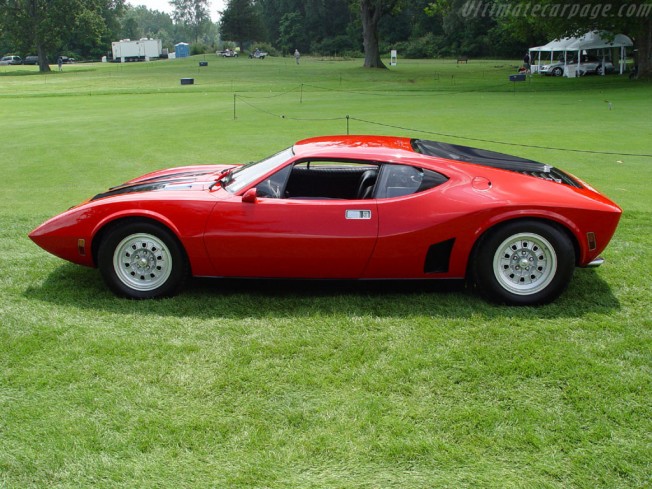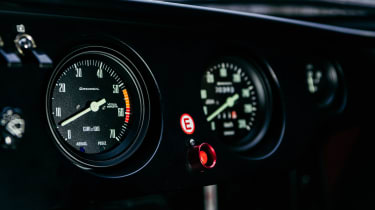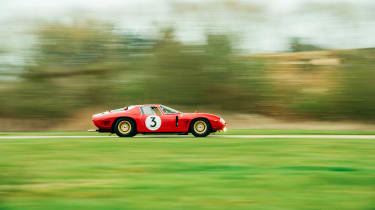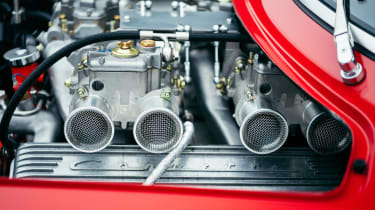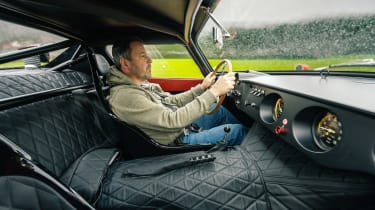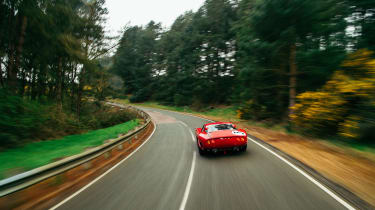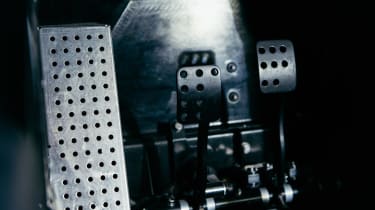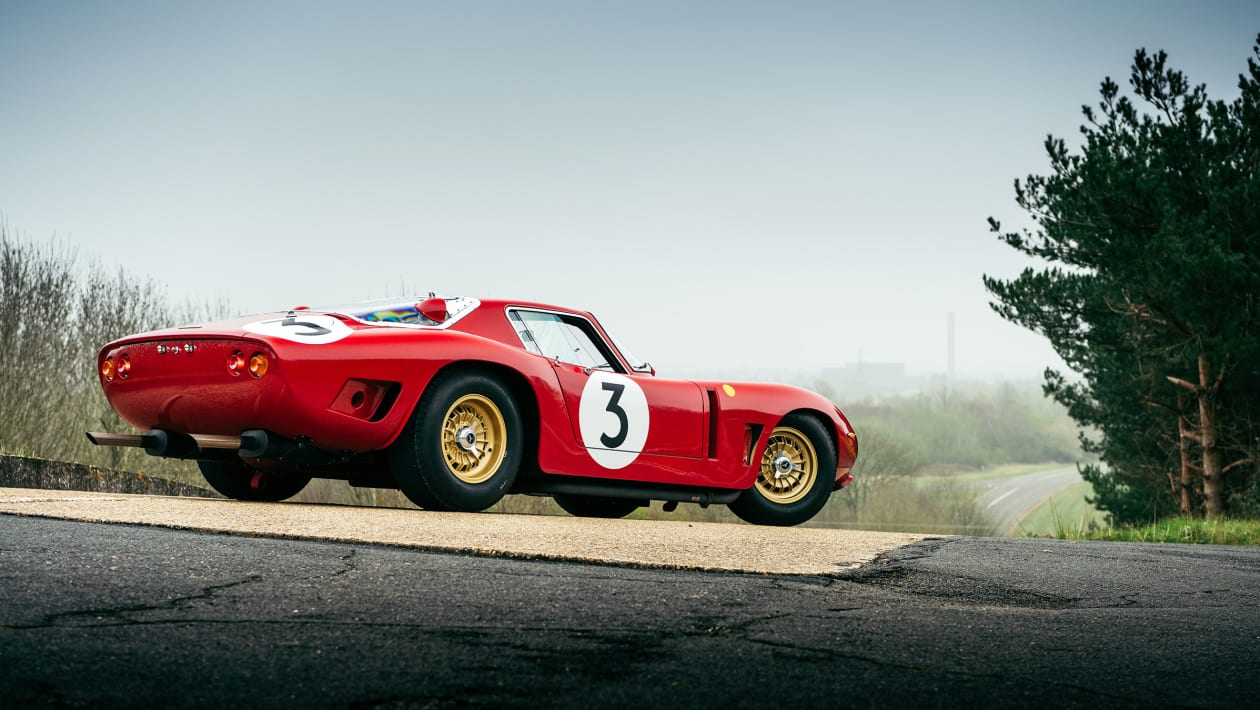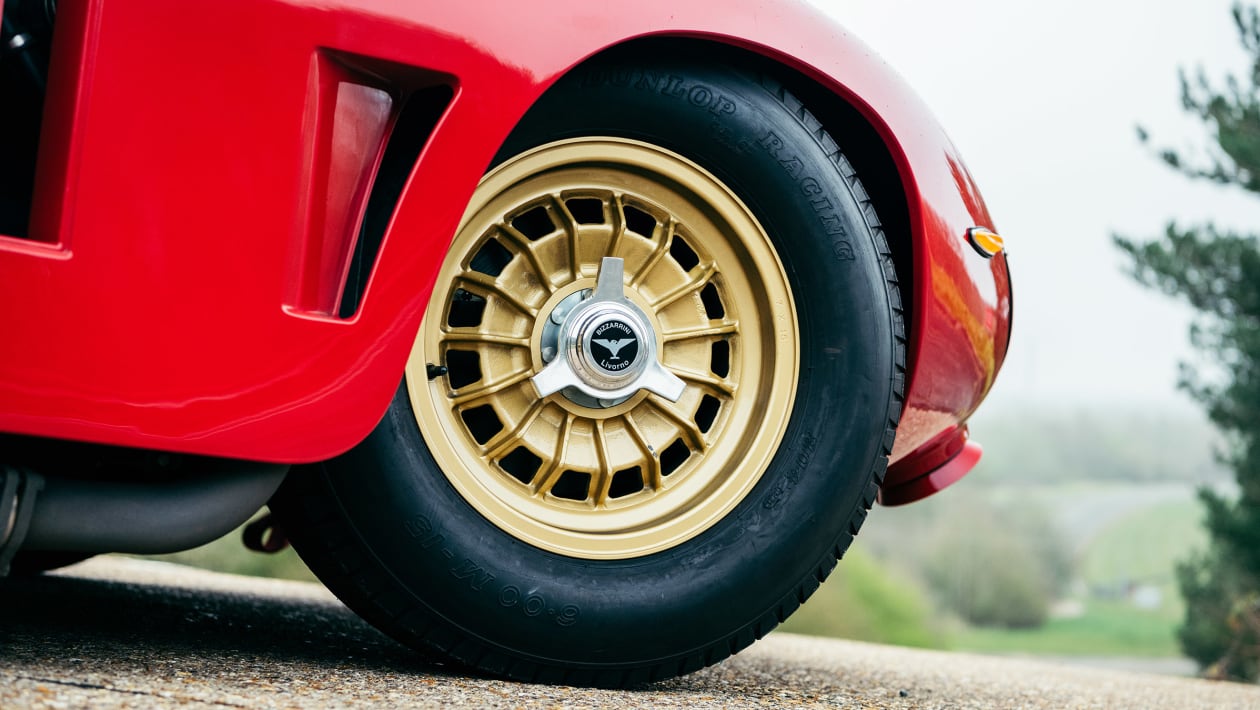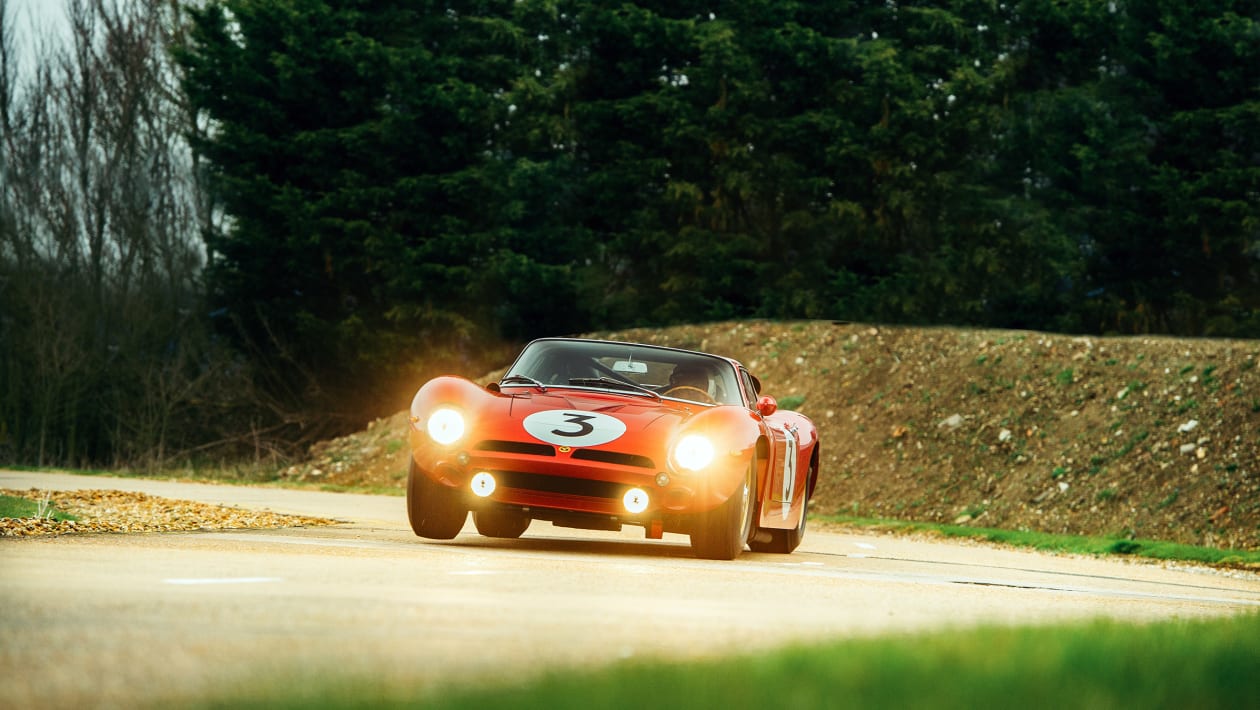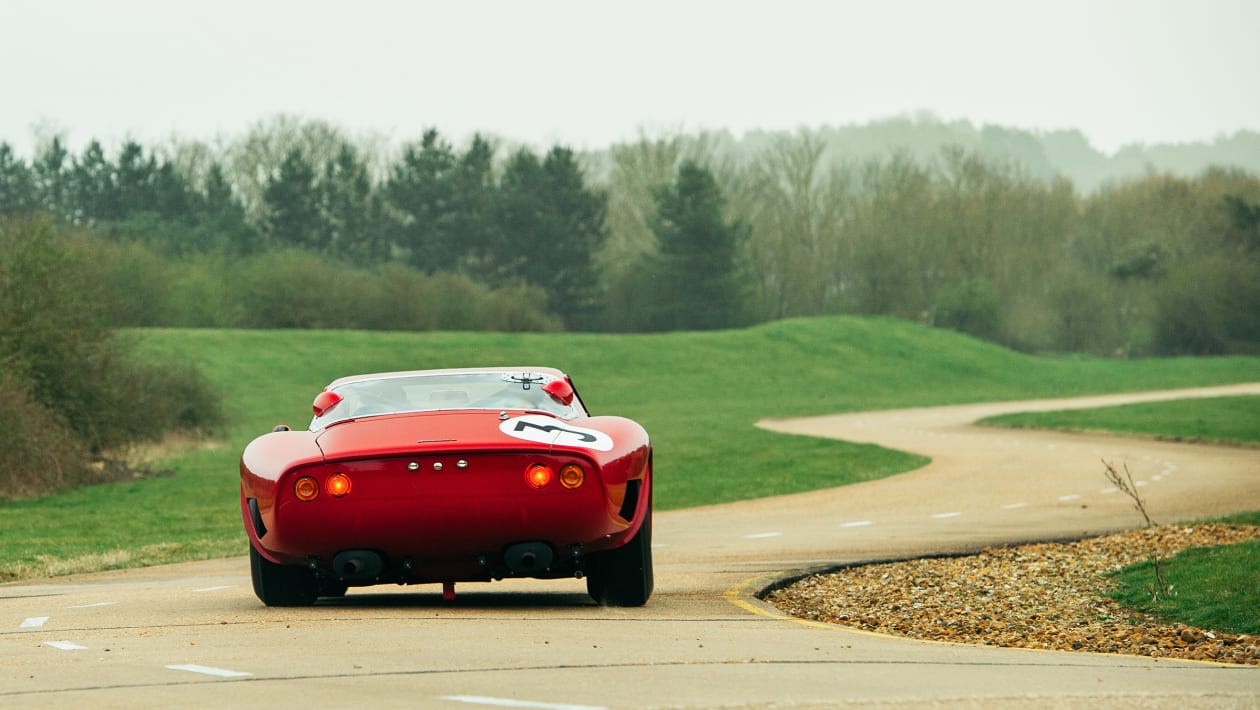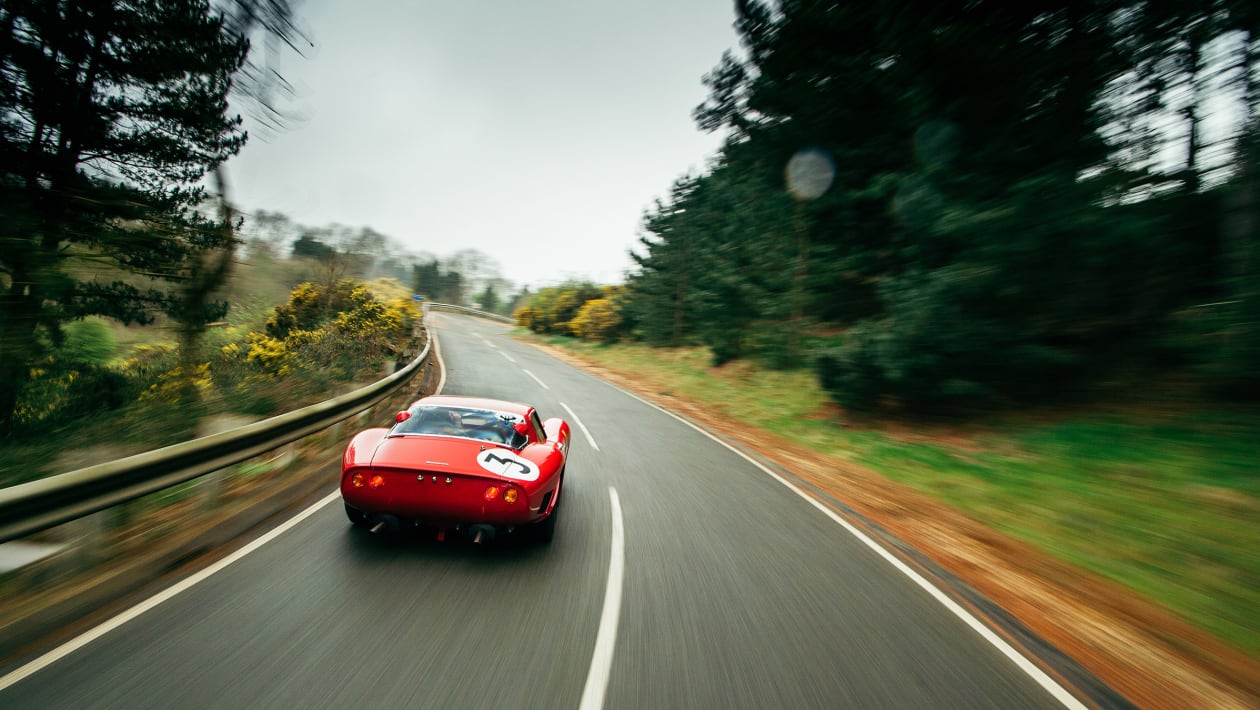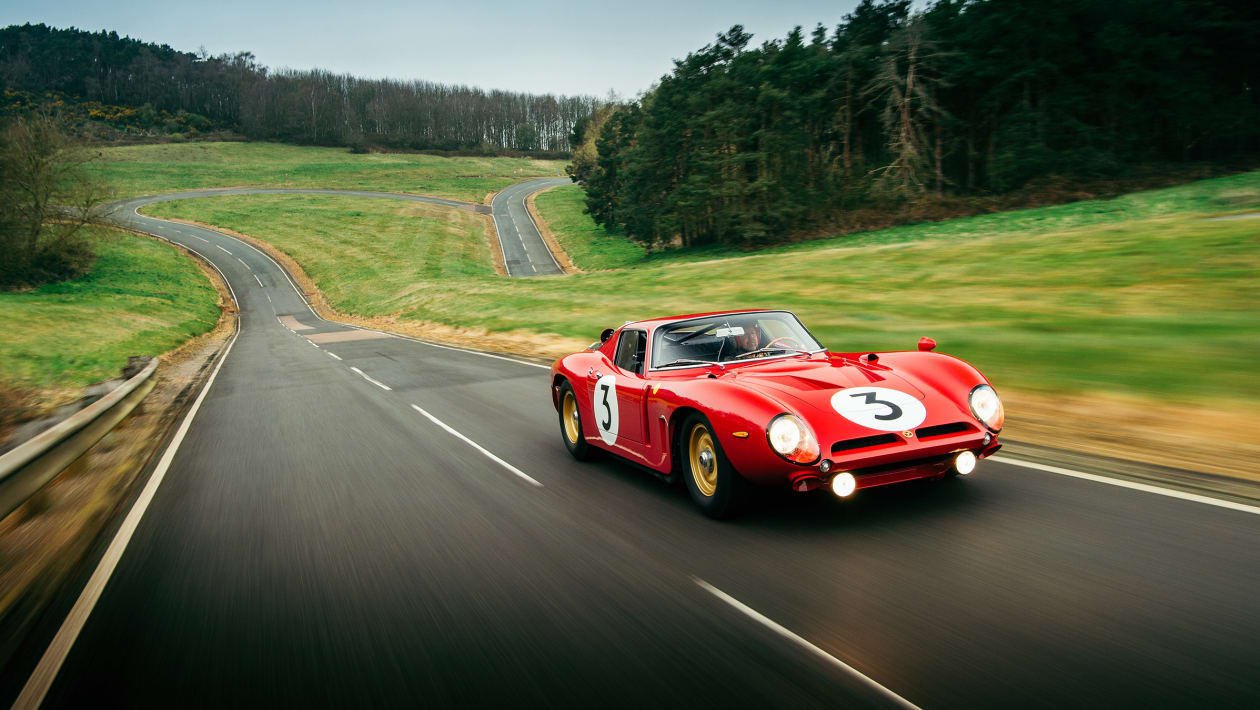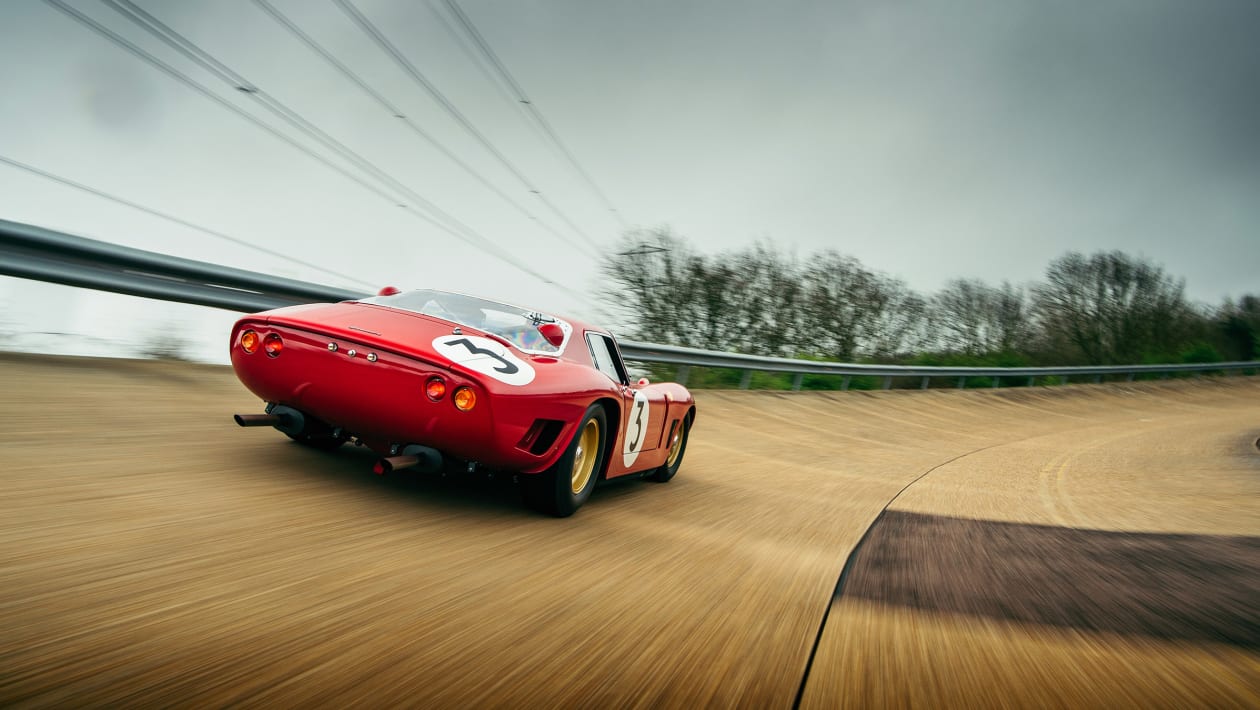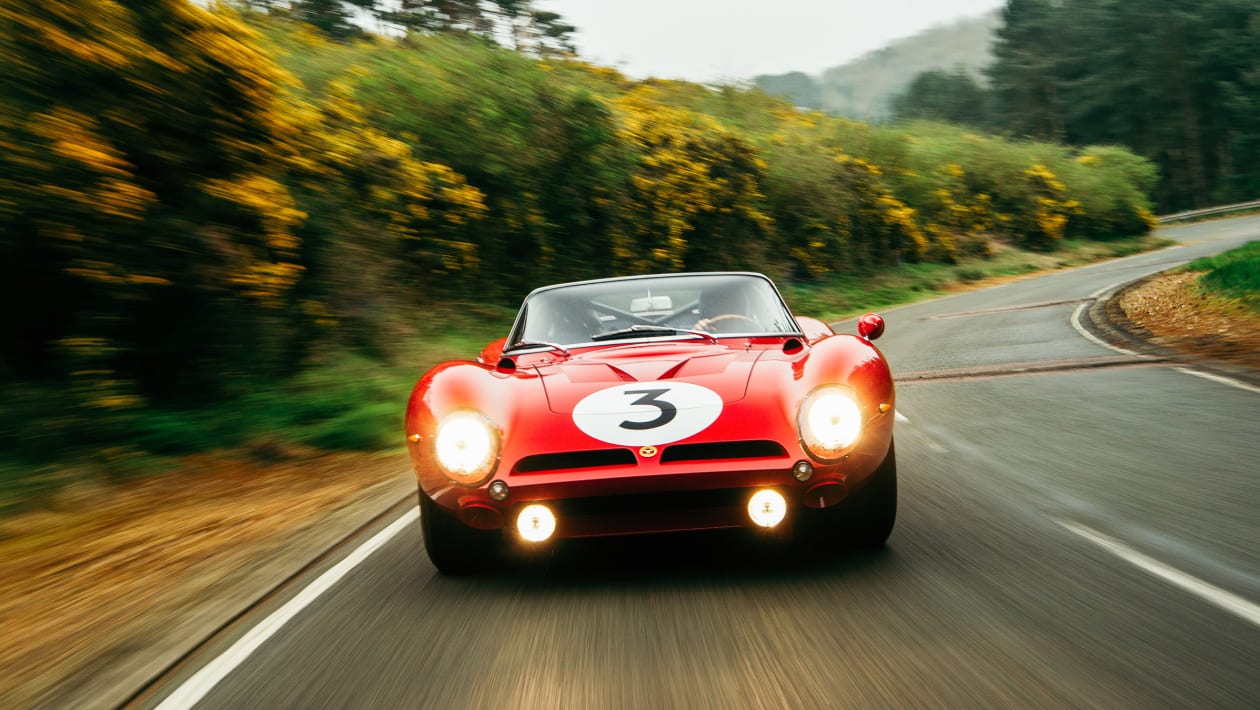cybermad
Clan Leader
- Modelo
- Z3 2.8 / GR86
- Registrado
- 11 Feb 2008
- Mensajes
- 107.089
- Reacciones
- 94.220
https://www.bloomberg.com/news/arti...-to-resurrect-italian-exotic-bizzarrini-again
Ex ejecutivos de Aston Martin resucitarán el 'hombre pensante de Ferrari '
La marca italiana de superdeportivos exóticos Bizzarrini está bajo una nueva dirección. Otra vez.
30 de diciembre de 2020 10:42 CET

Fotógrafo: Gooding & Co.
Navegar por el mundo de las desconocidas marcas de automóviles italianas después de haber recibido dinero en efectivo de patrocinadores de Oriente Medio o Asia es un poco como ver una película de espías de la década de 1960 sin sonido. O como leer artículos a ciegas en la página seis del sitio web de chismes .
Es hermoso, jugoso y, a veces, un poco confuso.
Bizzarrini, famosa por sus autos de carreras similares a los de Ferrari de la era de los 60, es la última marca histórica en recibir el tratamiento de nuevo. Es una tendencia que ha incluido más notablemente y recientemente a De Tomaso (famoso por el Pantera salvaje de los 70, que está respaldado por la firma de inversiones de Hong Kong Ideal Team Ventures) y Pininfarina , que acaba de presentar un superdeportivo eléctrico respaldado por Mahindra Group.
El 9 de noviembre, Pegasus Brands, con sede en Londres, anunció su intención de revivir Bizzarrini a pesar de que no ha fabricado un automóvil desde 1969. (Vea mi extenso manual de principios de este año sobre la herencia del "Ferrari del hombre pensante" y el potencial de inversión Pegasus, propiedad del ciudadano kuwaití Rezam Mohamed Al Roumi, es un concesionario internacional que representa a Aston Martin Lagonda, Rolls Royce Motor Cars, Koenigsegg, entre otros, con participaciones en Aston Martin Works, la histórica casa y fábrica de Aston Martin. carrocerías desde 1830.
Janette Green, la directora de marketing recién instalada en Bizzarrini, dijo en un correo electrónico que la corporación había comprado la marca Bizzarrini de "Bizzarrini Ltd." en agosto de 2019, que incluía todas las marcas comerciales, propiedad intelectual y otros activos. “La continuidad de la propiedad y la procedencia histórica permanece”, escribió Green, quien también es portavoz de Pegasus Auto, una aparente subsidiaria de Pegasus Brands. (Se rechazó una entrevista con Al Roumi; también se rechazó una solicitud de comentarios adicionales).

El cantante Johnny Hallyday admira un Bizzarrini 5300 GT en París, alrededor de 1960.
Fuente: Getty Images
Humo y espejos
Se siente como un déjà vu una vez más para una pequeña marca italiana que fabricó menos de 400 autos en su historia (el número exacto todavía se debate acaloradamente) y fue mal administrada hasta una rápida bancarrota. Por otra parte, eso ha estado a la par del curso con marcas exóticas y clásicas durante el siglo pasado.
La marca epónima de Giotto Bizzarrini surgió después de la salida del diseñador de Ferrari en 1960, cuando él y otros miembros clave del personal realizaron una huelga para protestar contra la política interna. Comenzó a asesorar a otras importantes marcas de automóviles italianas, incluidas Lamborghini e Iso, cuyos autos de carrera A3 / C con carrocería de
aluminio se convirtieron en los planos del primero de sus autos de marca propia, el Bizzarrini GT 5300 Strada. El Strada tenía el estilo bajo y ancho del A3 / C con un motor Corvette V8 de 365 caballos de fuerza montado en la parte delantera y central y una caja de cambios manual de cuatro velocidades. El hecho de que tuviera un motor de fabricación estadounidense perjudicó su popularidad y valor de inversión hasta hace poco.
El Strada tenía guardabarros delanteros inclinados y ventilaciones laterales que parecían branquias. En la pista de carreras, era conocido por su velocidad vertiginosa y su manejo elegante. El 1900 GT Europa y el P538S le seguirían antes de que la marca fuera declarada en quiebra en 1969. Bizzarrini, de 94 años, vive en Italia y fabrica coches por encargo; aparentemente no está asociado con la nueva versión de su antigua empresa.
Al menos tres ex ejecutivos de Aston Martin han firmado con la nueva empresa. Ulrich Bez, ex director ejecutivo de Aston Martin Lagonda Ltd., figura en los comunicados de prensa de la empresa como presidente de Bizzarrini; Christopher Shepherd, ex director ejecutivo de Aston Martin Middle East North Africa, figura como director ejecutivo; y Green, ex director de comunicaciones de marca global de Aston Martin Lagonda, figura como director de marketing. (Se rechazó una solicitud de entrevista con Bez).

Un Bizzarrini Iso Grifo A3 / C con motor Chevrolet conducido por Pierre Noblet y Edgar Berney.
Fotógrafo: Colección Klemantaski / Getty Images
Su presencia le da credibilidad al esfuerzo a pesar de que el propio Aston Martin flaqueó con ventas más pobres que los competidores durante la pandemia de coronavirus y objetivos de ventas significativamente marcados para 2025 y más allá, según el analista de Bloomberg Intelligence Michael Dean.
También es notable que Paolo Garella , el muy respetado ingeniero italiano que construyó el Glickenhaus SCG y Aspark Owl con su firma de diseño Manifattura Automobili Torino , estuvo en un momento asociado con la marca. Un foro de Ferrari de 2018 registra charlas en torno a una solicitud para las marcas registradas Scuderia Bizzarrini y Bizzarrini Livorno por Manifattura Automobili Torino, y fuentes cercanas a Garella han dicho que había llegado tan lejos como para concebir un moderno concepto de automóvil Bizzarrini como una forma de tomar el temperatura, por así decirlo, de los posibles compradores de UHNW.
Pero en un correo electrónico, Garella dijo que no está involucrado con el proyecto anunciado de Pegasus Brands y que la solicitud de marcas registradas no fue aceptada. “Lo hicimos para un grupo de inversionistas estadounidenses interesados en establecer una actividad de Restauración y Certificación en los Estados Unidos, pero desafortunadamente no sucedió”, dijo. Su participación en la marca, sin embargo, muestra que uno de los mejores ingenieros y diseñadores del mundo en un momento creyó que era prometedora.
El encanto de algo nuevo
Incluso la insinuación de una nueva versión de estos autos extremadamente coleccionables es notable para ese grupo de compradores de élite a quienes les gustan sus hipercoches modernos en el rango de $ 1 millón a $ 3 millones: aquellos que compran Koenigseggs , Paganis y Hennesseys . A fin de cuentas, no se necesitaría mucho para vender un Bizzarrini moderno de la misma manera en que los fabricantes de hipercoches de élite generan ingresos: producen un puñado de automóviles y encuentran a las personas en el mundo que quieren comprarlos.

El ASA "Mille" Competition GT en Italia en junio de 1963.
Fotógrafo: Colección Klemantaski / Getty Images
“Si Bizzarrini fue en la dirección en la que la marca se volvió a desarrollar realmente, realmente en torno a las carreras de algún tipo y luego los nuevos productos se desarrollaron con un espíritu de carreras y tecnología, eso podría ser una historia suficiente para contar, para darle a la marca algunas piernas ”, dice Chuck Wray, propietario de Grand Touring, un taller de restauración con sede en Virginia que se especializa en Bizzarrini y similares. "Hay tantas personas ricas en el mundo de hoy que este no es un modelo de negocio tan difícil".
El peligro, dice Wray, sería envolver una marca existente como Bizzarrini alrededor de productos inferiores en lugar de hacerla nueva nuevamente con ingeniería y tecnología emocionantes: “Realmente vas a tener que hacer algo más especial que los otros fabricantes de lotes pequeños, si ese es su modelo de negocio ”, dice. "De lo contrario, simplemente te desvanecerás en el olvido porque solo eras otro aspirante".
Mientras tanto, los chicos interesados en los viejos Bizzarrinis miran con curiosidad, aunque quizás no con la respiración contenida.
“Es interesante, pero es un proyecto de vanidad”, dice Steve Serio, el experto en automóviles de primera línea que vendió 12 de los 114 autos de carretera Bizzarrini 5300 originales existentes. En los últimos seis meses, ha facilitado la compra y venta privada de tres de ellos. “No hay un coleccionista de Bizzarrini desde hace mucho tiempo en el planeta al que le importaría una mierda [acerca de un auto nuevo Bizzarrini], porque todos compraron sus autos por alrededor de $ 100,000. No veo a ninguno de los tipos a los que he vendido Bizzarrini ni siquiera considerándolo ".
Esa mentalidad se aplica incluso a los coleccionistas que ahora pagan más de un millón de dólares por los originales, dice Serio. El valor medio actual de un Bizzarrini 5300 GT Strada en perfecto estado es de 1,2 millones de dólares, el triple de lo que era en 2010, según Jonathan Klinger, portavoz de Hagerty, y un Bizzarrini 5300 GT America en perfecto estado tiene un valor medio de 850.000 dólares. más de dos veces y media su valor en 2010. (Los GT 5300 originales vendidos en los EE. UU. cuestan $ 10,500, o $ 78,500 a las tarifas actuales, según Mark McCourt de Hemmings).
En 2015, los Keno Brothers Fine Automobile Auctioneers establecieron un récord con una Bizzarrini 5300 Strada de 1968 que se vendió por poco más de $ 1 millón, incluidas las tarifas. Pero el mercado privado es donde ocurren más del 90% de las transacciones de Bizzarrini.
En estos días, un GT 5300 Strada auténtico y en buenas condiciones con un cuerpo de aleación requiere al menos $ 1.5 millones para poseerlo, dice Serio. Y, por supuesto, el precio de venta será mucho más alto.
Se necesitará una cantidad considerable de magia, incluso para los italianos, ingleses y kuwaitíes que ahora trabajan juntos en su alquimia, para superar ese tipo de marcado.
---------------------
Former Aston Martin Execs to Resurrect the ‘Thinking Man’s Ferrari’
Italian exotic supercar brand Bizzarrini is under new management. Again.
By
Hannah Elliott
30 de diciembre de 2020

Photographer: Gooding & Co.
Navigating the world of obscure Italian car brands after they’ve been infused with cash from Middle Eastern or Asian backers is a little like watching a 1960s spy film with the sound off. Or like reading blind items on the gossip website Page Six.
It’s beautiful, juicy, and sometimes a little confusing.
Bizzarrini—famous for its ’60s-era Ferrari lookalike race cars—is the latest heritage brand to receive the new-again treatment. It’s a trend that’s included most notably and recently De Tomaso (famous for the ’70s-wild Pantera, which is backed by Hong Kong investment firm Ideal Team Ventures) and Pininfarina, which just introduced a electric supercar backed by Mahindra Group.
On Nov. 9, London-based Pegasus Brands announced its intention to revive Bizzarrini even though it hasn’t made a car since 1969. (See my extensive primer earlier this year on the heritage of the “thinking man’s Ferrari” and the investment potential of the cars.) Owned by Kuwaiti national Rezam Mohamed Al Roumi, Pegasus is an international dealership that represents Aston Martin Lagonda, Rolls Royce Motor Cars, Koenigsegg, among others, with holdings in Aston Martin Works, the historic home and factory of Aston Martin coachworks since 1830.
Janette Green, the newly installed chief marketing officer at Bizzarrini, said in an email that the corporation had purchased the Bizzarrini marque from “Bizzarrini Ltd.” in August 2019, which included all trademarks, intellectual property, and other assets. “The continuity of ownership and historical provenance remains,” wrote Green, who is also a spokesperson for Pegasus Auto, an apparent subsidiary of Pegasus Brands. (An interview with Al Roumi was declined; a request for additional comment was also declined.)

Singer Johnny Hallyday admires a Bizzarrini 5300 GT in Paris, circa 1960.
Source: Getty Images
Smoke and Mirrors
It’s feeling like déjà vu all over again for a tiny Italian brand that made fewer than 400 cars in its history—the exact number is still hotly debated—and was mismanaged into a quick bankruptcy. Then again, that’s been par for the course with exotic and classic marques for the past century.
Giotto Bizzarrini’s eponymous brand arose after the designer’s departure from Ferrari in 1960, when he and other key staff members staged a walkout to protest internal politics. He started consulting for other prominent Italian car brands, including Lamborghini and Iso, whose aluminum-bodied A3/C race cars became the blueprints for the first
of his self-branded cars, the Bizzarrini GT 5300 Strada. The Strada had the low, wide styling of the A3/C with a front-mid-mounted, 365-horsepower Corvette V8 engine and a four-speed manual gearbox. The fact that it had an American-made engine hurt its popularity and investment value until recently.
The Strada had swooping front fenders and side vents that looked like gills. On the racetrack, it was known for blazing speed and elegant handling. The 1900 GT Europa and P538S would follow before the brand was declared bankrupt in 1969. Bizzarrini, 94, lives in Italy and builds cars on commission; he’s apparently not associated with the new iteration of his former company.
At least three former Aston Martin executives have signed on with the new company. Ulrich Bez, formerly the chief executive officer of Aston Martin Lagonda Ltd., is listed in company press statements as chairman of Bizzarrini; Christopher Shepherd, formerly the CEO of Aston Martin Middle East North Africa, is listed as CEO; and Green, a former global brand communications director at Aston Martin Lagonda, is listed as chief marketing officer. (A request for an interview with Bez was declined.)

A Chevrolet-powered Bizzarrini Iso Grifo A3/C driven by Pierre Noblet and Edgar Berney.
Photographer: Klemantaski Collection/Getty Images
Their presence lends credibility to the endeavor despite Aston Martin itself faltering with poorer sales than competitors during the coronavirus pandemic and significantly dialed-back sales targets for 2025 and beyond, according to Bloomberg Intelligence analyst Michael Dean.
It’s also notable that Paolo Garella, the highly respected Italian engineer who built the Glickenhaus SCG and Aspark Owl with his Manifattura Automobili Torino design firm, was at one time associated with the brand. A Ferrari forum from 2018 records chatter surrounding an application for both Scuderia Bizzarrini and Bizzarrini Livorno trademarks by Manifattura Automobili Torino—and sources close to Garella have said he’d gone so far as to conceive a modern Bizzarrini concept car as a way to take the temperature, as it were, of UHNW prospective buyers.
But in an email, Garella said that he’s not involved with the announced Pegasus Brands project and that the trademarks request was not accepted. “We did it for a group of U.S. investors interested in setting up Restoration and Certification activity in the U.S., but unfortunately it did not happen,” he said. His involvement with the brand, however, shows one of the world’s best engineers and designers at one time believed it held promise.
The Allure of Something New
Even the hint of a new version of these extremely collectible cars is notable to that uber-elite group of buyers who like their modern hypercars in the $1 million to $3 million range—those who buy Koenigseggs, Paganis, and Hennesseys. It wouldn’t take much, all things considered, to sell a modern Bizzarrini in much the same way elite hypercar makers conjure revenue: They produce a handful of cars and find those people in the world who want to buy them.

The ASA "Mille" Competition GT in Italy in June 1963.
Photographer: Klemantaski Collection/Getty Images
“If Bizzarrini went in the direction where the brand was redeveloped really, truly around racing of some sort and then the new products were developed out of a spirit of racing and technology, that might be enough of a story to tell, to give the brand some legs,” says Chuck Wray, owner of Grand Touring, a Virginia-based restoration shop that specializes in Bizzarrini and similar ilk. “There are just so many wealthy people in the world today that this is not that hard of a business model.”
The danger, Wray says, would be in wrapping an existing brand name like Bizzarrini around inferior products rather than making it new again with exciting engineering and technology: “You really are going to have to do something more special than the other small batch manufactures, if that’s your business model,” he says. “Otherwise, you will just fade off into oblivion because you were just another wannabe.”
Meanwhile, the guys interested in the old Bizzarrinis are watching with curiosity, though not, perhaps, with bated breath.
“It’s interesting, but it’s a vanity project,” says Steve Serio, the blue-chip car expert who’s sold 12 of the existing 114 original Bizzarrini 5300 road cars. In the past six months, he’s facilitated the private sale and purchase of three of them. “There isn’t a long-time Bizzarrini collector on the planet who would give a crap [about a new Bizzarrini car], because they all bought their cars for about $100,000. I don’t see any of the guys I’ve ever sold Bizzarrini to even considering it.”
That mentality applies even to collectors now paying $1 million-plus for the originals, Serio says. The average value today of a Bizzarrini 5300 GT Strada in perfect condition is $1.2 million, triple what it was in 2010, according to Jonathan Klinger, a spokesman for Hagerty, and a Bizzarrini 5300 GT America in perfect condition has an average value of $850,000—more than two and a half times its value in 2010. (The original GT 5300s sold in the U.S. cost $10,500, or $78,500 at today’s rates, according to Hemmings’s Mark McCourt.)
In 2015 the Keno Brothers Fine Automobile Auctioneers set a record with a 1968 Bizzarrini 5300 Strada selling for just over $1 million, including fees. But the private market is where more than 90% of Bizzarrini transactions occur.
These days, an authentic, good-condition GT 5300 Strada with an alloy body requires at least $1.5 million to own, Serio says. And, of course, the asking price will be much higher.
It will take considerable magic—even for the Italians, English, and Kuwaitis now working their alchemy together—to top that kind of markup.
Ex ejecutivos de Aston Martin resucitarán el 'hombre pensante de Ferrari '
La marca italiana de superdeportivos exóticos Bizzarrini está bajo una nueva dirección. Otra vez.
30 de diciembre de 2020 10:42 CET

Fotógrafo: Gooding & Co.
Navegar por el mundo de las desconocidas marcas de automóviles italianas después de haber recibido dinero en efectivo de patrocinadores de Oriente Medio o Asia es un poco como ver una película de espías de la década de 1960 sin sonido. O como leer artículos a ciegas en la página seis del sitio web de chismes .
Es hermoso, jugoso y, a veces, un poco confuso.
Bizzarrini, famosa por sus autos de carreras similares a los de Ferrari de la era de los 60, es la última marca histórica en recibir el tratamiento de nuevo. Es una tendencia que ha incluido más notablemente y recientemente a De Tomaso (famoso por el Pantera salvaje de los 70, que está respaldado por la firma de inversiones de Hong Kong Ideal Team Ventures) y Pininfarina , que acaba de presentar un superdeportivo eléctrico respaldado por Mahindra Group.
El 9 de noviembre, Pegasus Brands, con sede en Londres, anunció su intención de revivir Bizzarrini a pesar de que no ha fabricado un automóvil desde 1969. (Vea mi extenso manual de principios de este año sobre la herencia del "Ferrari del hombre pensante" y el potencial de inversión Pegasus, propiedad del ciudadano kuwaití Rezam Mohamed Al Roumi, es un concesionario internacional que representa a Aston Martin Lagonda, Rolls Royce Motor Cars, Koenigsegg, entre otros, con participaciones en Aston Martin Works, la histórica casa y fábrica de Aston Martin. carrocerías desde 1830.
Janette Green, la directora de marketing recién instalada en Bizzarrini, dijo en un correo electrónico que la corporación había comprado la marca Bizzarrini de "Bizzarrini Ltd." en agosto de 2019, que incluía todas las marcas comerciales, propiedad intelectual y otros activos. “La continuidad de la propiedad y la procedencia histórica permanece”, escribió Green, quien también es portavoz de Pegasus Auto, una aparente subsidiaria de Pegasus Brands. (Se rechazó una entrevista con Al Roumi; también se rechazó una solicitud de comentarios adicionales).

El cantante Johnny Hallyday admira un Bizzarrini 5300 GT en París, alrededor de 1960.
Fuente: Getty Images
Humo y espejos
Se siente como un déjà vu una vez más para una pequeña marca italiana que fabricó menos de 400 autos en su historia (el número exacto todavía se debate acaloradamente) y fue mal administrada hasta una rápida bancarrota. Por otra parte, eso ha estado a la par del curso con marcas exóticas y clásicas durante el siglo pasado.
La marca epónima de Giotto Bizzarrini surgió después de la salida del diseñador de Ferrari en 1960, cuando él y otros miembros clave del personal realizaron una huelga para protestar contra la política interna. Comenzó a asesorar a otras importantes marcas de automóviles italianas, incluidas Lamborghini e Iso, cuyos autos de carrera A3 / C con carrocería de
aluminio se convirtieron en los planos del primero de sus autos de marca propia, el Bizzarrini GT 5300 Strada. El Strada tenía el estilo bajo y ancho del A3 / C con un motor Corvette V8 de 365 caballos de fuerza montado en la parte delantera y central y una caja de cambios manual de cuatro velocidades. El hecho de que tuviera un motor de fabricación estadounidense perjudicó su popularidad y valor de inversión hasta hace poco.
El Strada tenía guardabarros delanteros inclinados y ventilaciones laterales que parecían branquias. En la pista de carreras, era conocido por su velocidad vertiginosa y su manejo elegante. El 1900 GT Europa y el P538S le seguirían antes de que la marca fuera declarada en quiebra en 1969. Bizzarrini, de 94 años, vive en Italia y fabrica coches por encargo; aparentemente no está asociado con la nueva versión de su antigua empresa.
Al menos tres ex ejecutivos de Aston Martin han firmado con la nueva empresa. Ulrich Bez, ex director ejecutivo de Aston Martin Lagonda Ltd., figura en los comunicados de prensa de la empresa como presidente de Bizzarrini; Christopher Shepherd, ex director ejecutivo de Aston Martin Middle East North Africa, figura como director ejecutivo; y Green, ex director de comunicaciones de marca global de Aston Martin Lagonda, figura como director de marketing. (Se rechazó una solicitud de entrevista con Bez).

Un Bizzarrini Iso Grifo A3 / C con motor Chevrolet conducido por Pierre Noblet y Edgar Berney.
Fotógrafo: Colección Klemantaski / Getty Images
Su presencia le da credibilidad al esfuerzo a pesar de que el propio Aston Martin flaqueó con ventas más pobres que los competidores durante la pandemia de coronavirus y objetivos de ventas significativamente marcados para 2025 y más allá, según el analista de Bloomberg Intelligence Michael Dean.
También es notable que Paolo Garella , el muy respetado ingeniero italiano que construyó el Glickenhaus SCG y Aspark Owl con su firma de diseño Manifattura Automobili Torino , estuvo en un momento asociado con la marca. Un foro de Ferrari de 2018 registra charlas en torno a una solicitud para las marcas registradas Scuderia Bizzarrini y Bizzarrini Livorno por Manifattura Automobili Torino, y fuentes cercanas a Garella han dicho que había llegado tan lejos como para concebir un moderno concepto de automóvil Bizzarrini como una forma de tomar el temperatura, por así decirlo, de los posibles compradores de UHNW.
Pero en un correo electrónico, Garella dijo que no está involucrado con el proyecto anunciado de Pegasus Brands y que la solicitud de marcas registradas no fue aceptada. “Lo hicimos para un grupo de inversionistas estadounidenses interesados en establecer una actividad de Restauración y Certificación en los Estados Unidos, pero desafortunadamente no sucedió”, dijo. Su participación en la marca, sin embargo, muestra que uno de los mejores ingenieros y diseñadores del mundo en un momento creyó que era prometedora.
El encanto de algo nuevo
Incluso la insinuación de una nueva versión de estos autos extremadamente coleccionables es notable para ese grupo de compradores de élite a quienes les gustan sus hipercoches modernos en el rango de $ 1 millón a $ 3 millones: aquellos que compran Koenigseggs , Paganis y Hennesseys . A fin de cuentas, no se necesitaría mucho para vender un Bizzarrini moderno de la misma manera en que los fabricantes de hipercoches de élite generan ingresos: producen un puñado de automóviles y encuentran a las personas en el mundo que quieren comprarlos.

El ASA "Mille" Competition GT en Italia en junio de 1963.
Fotógrafo: Colección Klemantaski / Getty Images
“Si Bizzarrini fue en la dirección en la que la marca se volvió a desarrollar realmente, realmente en torno a las carreras de algún tipo y luego los nuevos productos se desarrollaron con un espíritu de carreras y tecnología, eso podría ser una historia suficiente para contar, para darle a la marca algunas piernas ”, dice Chuck Wray, propietario de Grand Touring, un taller de restauración con sede en Virginia que se especializa en Bizzarrini y similares. "Hay tantas personas ricas en el mundo de hoy que este no es un modelo de negocio tan difícil".
El peligro, dice Wray, sería envolver una marca existente como Bizzarrini alrededor de productos inferiores en lugar de hacerla nueva nuevamente con ingeniería y tecnología emocionantes: “Realmente vas a tener que hacer algo más especial que los otros fabricantes de lotes pequeños, si ese es su modelo de negocio ”, dice. "De lo contrario, simplemente te desvanecerás en el olvido porque solo eras otro aspirante".
Mientras tanto, los chicos interesados en los viejos Bizzarrinis miran con curiosidad, aunque quizás no con la respiración contenida.
“Es interesante, pero es un proyecto de vanidad”, dice Steve Serio, el experto en automóviles de primera línea que vendió 12 de los 114 autos de carretera Bizzarrini 5300 originales existentes. En los últimos seis meses, ha facilitado la compra y venta privada de tres de ellos. “No hay un coleccionista de Bizzarrini desde hace mucho tiempo en el planeta al que le importaría una mierda [acerca de un auto nuevo Bizzarrini], porque todos compraron sus autos por alrededor de $ 100,000. No veo a ninguno de los tipos a los que he vendido Bizzarrini ni siquiera considerándolo ".
Esa mentalidad se aplica incluso a los coleccionistas que ahora pagan más de un millón de dólares por los originales, dice Serio. El valor medio actual de un Bizzarrini 5300 GT Strada en perfecto estado es de 1,2 millones de dólares, el triple de lo que era en 2010, según Jonathan Klinger, portavoz de Hagerty, y un Bizzarrini 5300 GT America en perfecto estado tiene un valor medio de 850.000 dólares. más de dos veces y media su valor en 2010. (Los GT 5300 originales vendidos en los EE. UU. cuestan $ 10,500, o $ 78,500 a las tarifas actuales, según Mark McCourt de Hemmings).
En 2015, los Keno Brothers Fine Automobile Auctioneers establecieron un récord con una Bizzarrini 5300 Strada de 1968 que se vendió por poco más de $ 1 millón, incluidas las tarifas. Pero el mercado privado es donde ocurren más del 90% de las transacciones de Bizzarrini.
En estos días, un GT 5300 Strada auténtico y en buenas condiciones con un cuerpo de aleación requiere al menos $ 1.5 millones para poseerlo, dice Serio. Y, por supuesto, el precio de venta será mucho más alto.
Se necesitará una cantidad considerable de magia, incluso para los italianos, ingleses y kuwaitíes que ahora trabajan juntos en su alquimia, para superar ese tipo de marcado.
---------------------
Former Aston Martin Execs to Resurrect the ‘Thinking Man’s Ferrari’
Italian exotic supercar brand Bizzarrini is under new management. Again.
By
Hannah Elliott
30 de diciembre de 2020

Photographer: Gooding & Co.
Navigating the world of obscure Italian car brands after they’ve been infused with cash from Middle Eastern or Asian backers is a little like watching a 1960s spy film with the sound off. Or like reading blind items on the gossip website Page Six.
It’s beautiful, juicy, and sometimes a little confusing.
Bizzarrini—famous for its ’60s-era Ferrari lookalike race cars—is the latest heritage brand to receive the new-again treatment. It’s a trend that’s included most notably and recently De Tomaso (famous for the ’70s-wild Pantera, which is backed by Hong Kong investment firm Ideal Team Ventures) and Pininfarina, which just introduced a electric supercar backed by Mahindra Group.
On Nov. 9, London-based Pegasus Brands announced its intention to revive Bizzarrini even though it hasn’t made a car since 1969. (See my extensive primer earlier this year on the heritage of the “thinking man’s Ferrari” and the investment potential of the cars.) Owned by Kuwaiti national Rezam Mohamed Al Roumi, Pegasus is an international dealership that represents Aston Martin Lagonda, Rolls Royce Motor Cars, Koenigsegg, among others, with holdings in Aston Martin Works, the historic home and factory of Aston Martin coachworks since 1830.
Janette Green, the newly installed chief marketing officer at Bizzarrini, said in an email that the corporation had purchased the Bizzarrini marque from “Bizzarrini Ltd.” in August 2019, which included all trademarks, intellectual property, and other assets. “The continuity of ownership and historical provenance remains,” wrote Green, who is also a spokesperson for Pegasus Auto, an apparent subsidiary of Pegasus Brands. (An interview with Al Roumi was declined; a request for additional comment was also declined.)

Singer Johnny Hallyday admires a Bizzarrini 5300 GT in Paris, circa 1960.
Source: Getty Images
Smoke and Mirrors
It’s feeling like déjà vu all over again for a tiny Italian brand that made fewer than 400 cars in its history—the exact number is still hotly debated—and was mismanaged into a quick bankruptcy. Then again, that’s been par for the course with exotic and classic marques for the past century.
Giotto Bizzarrini’s eponymous brand arose after the designer’s departure from Ferrari in 1960, when he and other key staff members staged a walkout to protest internal politics. He started consulting for other prominent Italian car brands, including Lamborghini and Iso, whose aluminum-bodied A3/C race cars became the blueprints for the first
of his self-branded cars, the Bizzarrini GT 5300 Strada. The Strada had the low, wide styling of the A3/C with a front-mid-mounted, 365-horsepower Corvette V8 engine and a four-speed manual gearbox. The fact that it had an American-made engine hurt its popularity and investment value until recently.
The Strada had swooping front fenders and side vents that looked like gills. On the racetrack, it was known for blazing speed and elegant handling. The 1900 GT Europa and P538S would follow before the brand was declared bankrupt in 1969. Bizzarrini, 94, lives in Italy and builds cars on commission; he’s apparently not associated with the new iteration of his former company.
At least three former Aston Martin executives have signed on with the new company. Ulrich Bez, formerly the chief executive officer of Aston Martin Lagonda Ltd., is listed in company press statements as chairman of Bizzarrini; Christopher Shepherd, formerly the CEO of Aston Martin Middle East North Africa, is listed as CEO; and Green, a former global brand communications director at Aston Martin Lagonda, is listed as chief marketing officer. (A request for an interview with Bez was declined.)

A Chevrolet-powered Bizzarrini Iso Grifo A3/C driven by Pierre Noblet and Edgar Berney.
Photographer: Klemantaski Collection/Getty Images
Their presence lends credibility to the endeavor despite Aston Martin itself faltering with poorer sales than competitors during the coronavirus pandemic and significantly dialed-back sales targets for 2025 and beyond, according to Bloomberg Intelligence analyst Michael Dean.
It’s also notable that Paolo Garella, the highly respected Italian engineer who built the Glickenhaus SCG and Aspark Owl with his Manifattura Automobili Torino design firm, was at one time associated with the brand. A Ferrari forum from 2018 records chatter surrounding an application for both Scuderia Bizzarrini and Bizzarrini Livorno trademarks by Manifattura Automobili Torino—and sources close to Garella have said he’d gone so far as to conceive a modern Bizzarrini concept car as a way to take the temperature, as it were, of UHNW prospective buyers.
But in an email, Garella said that he’s not involved with the announced Pegasus Brands project and that the trademarks request was not accepted. “We did it for a group of U.S. investors interested in setting up Restoration and Certification activity in the U.S., but unfortunately it did not happen,” he said. His involvement with the brand, however, shows one of the world’s best engineers and designers at one time believed it held promise.
The Allure of Something New
Even the hint of a new version of these extremely collectible cars is notable to that uber-elite group of buyers who like their modern hypercars in the $1 million to $3 million range—those who buy Koenigseggs, Paganis, and Hennesseys. It wouldn’t take much, all things considered, to sell a modern Bizzarrini in much the same way elite hypercar makers conjure revenue: They produce a handful of cars and find those people in the world who want to buy them.

The ASA "Mille" Competition GT in Italy in June 1963.
Photographer: Klemantaski Collection/Getty Images
“If Bizzarrini went in the direction where the brand was redeveloped really, truly around racing of some sort and then the new products were developed out of a spirit of racing and technology, that might be enough of a story to tell, to give the brand some legs,” says Chuck Wray, owner of Grand Touring, a Virginia-based restoration shop that specializes in Bizzarrini and similar ilk. “There are just so many wealthy people in the world today that this is not that hard of a business model.”
The danger, Wray says, would be in wrapping an existing brand name like Bizzarrini around inferior products rather than making it new again with exciting engineering and technology: “You really are going to have to do something more special than the other small batch manufactures, if that’s your business model,” he says. “Otherwise, you will just fade off into oblivion because you were just another wannabe.”
Meanwhile, the guys interested in the old Bizzarrinis are watching with curiosity, though not, perhaps, with bated breath.
“It’s interesting, but it’s a vanity project,” says Steve Serio, the blue-chip car expert who’s sold 12 of the existing 114 original Bizzarrini 5300 road cars. In the past six months, he’s facilitated the private sale and purchase of three of them. “There isn’t a long-time Bizzarrini collector on the planet who would give a crap [about a new Bizzarrini car], because they all bought their cars for about $100,000. I don’t see any of the guys I’ve ever sold Bizzarrini to even considering it.”
That mentality applies even to collectors now paying $1 million-plus for the originals, Serio says. The average value today of a Bizzarrini 5300 GT Strada in perfect condition is $1.2 million, triple what it was in 2010, according to Jonathan Klinger, a spokesman for Hagerty, and a Bizzarrini 5300 GT America in perfect condition has an average value of $850,000—more than two and a half times its value in 2010. (The original GT 5300s sold in the U.S. cost $10,500, or $78,500 at today’s rates, according to Hemmings’s Mark McCourt.)
In 2015 the Keno Brothers Fine Automobile Auctioneers set a record with a 1968 Bizzarrini 5300 Strada selling for just over $1 million, including fees. But the private market is where more than 90% of Bizzarrini transactions occur.
These days, an authentic, good-condition GT 5300 Strada with an alloy body requires at least $1.5 million to own, Serio says. And, of course, the asking price will be much higher.
It will take considerable magic—even for the Italians, English, and Kuwaitis now working their alchemy together—to top that kind of markup.


